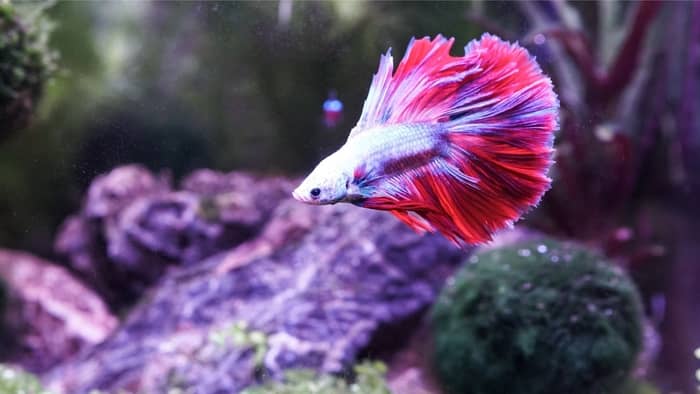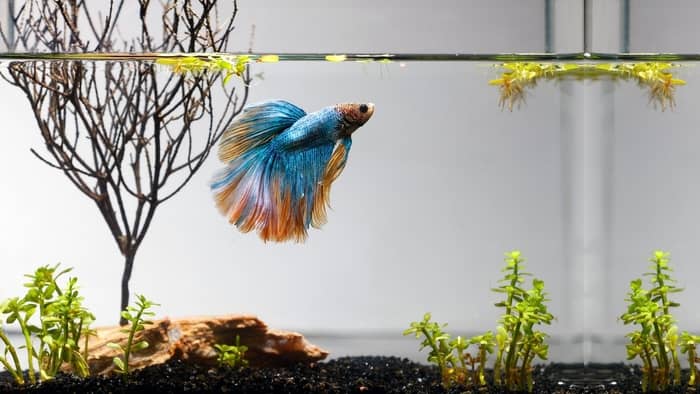Last Updated on October 24, 2022 by admins
Hobbyists often suggest using aquarium salt for Betta fin rot. Stay with us and find out if this is a proven cure for this type of disease.
Fine rot in Betta is one of the most common diseases that occur. Hobbyists, especially beginners, almost always panic when they notice that the disease has affected their beautiful and unique fishes. However, is there a reason to worry about it? Keep reading and find out how to use aquarium salt for Betta fin rot.
What is Betta Fin Rot?
Betta fin rot is a bacterial or fungal infection that most commonly affects Betta fish. It usually occurs in uncycled tanks and small bowls and is known for attacking and eating the beautiful fins of Betta fish.
Keep in mind that a good portion of Bettas purchased in stores may already show signs of fin rot due to water quality and temperature problems in small tanks. However, don’t confuse fin rot with fin biting, tearing, or splitting. They are the result of physical injury from boredom, fighting, or snagging sharp decor. The two are most easily distinguished by the lack of white, red, or black edges around the deterioration.
Another thing we must mention is not to panic because fine rot is very common and usually not deadly. Moreover, it is such a common disease because it is caused by bacteria that naturally exist in the water of your aquarium. Namely, these bacteria will not harm your fish until its immunity is weakened.
Fin rot is most often caused by poor conditions in the aquarium tank. Some of the triggers closely related to the occurrence of this disease are cold and cloudy water, saturation with uneaten food and globs of feces, as well as elevated levels of ammonium, nitrite, and nitrate.

Symptoms of disease
This disease has several stages that vary in symptoms from mild to extremely severe. Always try to catch it in time to avoid the more severe consequences of an infection. It is best to always take care of the Dorsal (top), Caudal (tail), and Anal (bottom) fin of your Betta fish as they are the easiest fins to check and accordingly identify if an infection has occurred.
Keep reading to find out the typical symptoms by which you can recognize the degree of the disease.
Mild Fin Rot
Mild Fin Rot is known for causing brownish fin edges, jagged fin edges, and whitish tips or spots.
Moderate Fin Rot
Moderate Fin Rot most often causes large fin deterioration and receding, and black or in worse cases bloody fin edges. Finally, you can recognize this stage of the disease by the fact that the fins of your Betta fish begin to develop fuzzy growths.
Severe Fin Rot
Severe Fin Rot is characterized by inflammation of the fin base, bloody fin bases, entire loss of fins and fin membranes, cottony growths on the body, body rot, and lethargy. In addition, your Betta fish will find it harder to swim and will usually become susceptible to other diseases due to stress.
Can I Use Aquarium Salt For Betta Fin Rot?
That is right, you can use aquarium salt to cure fin rot in your Betta fishes. Medications intended to treat this disease are quite aggressive and can have multiple side effects. Therefore, it is actually recommended to use aquarium salt for Betta fin rot. This method is most often used in milder forms of this disease.
As for the use of aquarium salt for Betta fin rot, it is quite simple. It is recommended to use 1 tablespoon of salt per gallon of water for mild fin rot and 2 to 2.5 tablespoons per gallon of water for a moderate degree of disease.
It is necessary to dissolve the aquarium salt in a separate container first and only then add equal parts of the solution in 1-hour intervals. The solution should be left in the aquarium for at least 24 hours. Then, it is necessary to change 100 % of the water and replace it with conditioned tap water of the same temperature as before.
As for the frequency of treatment, the process can be repeated for a week and a half, but it is necessary to take care that your pets don’t suffer from stress. If you have the opportunity, the best option would be to treat the infected fish in a special quarantine aquarium and return them to their home after the treatment.

Abstract
If you notice symptoms of this disease on your Betta fish, don’t panic because fine rot is not a contagious condition and will not spread from one fish to another. Neglecting your aquarium tank is a major cause of this disease. Therefore, keep in mind that prevention is better than cure.
That would be it, now you know how to use aquarium salt for Betta fin rot. If you have any questions, let us know in the section below.
Take a look at this article as well.
FAQs
Is Aquarium Salt Good For Bettas?
As long as you handle it properly or if you don’t overdo it, aquarium salt is perfectly safe for Bettas. Moreover, it is recommended for the treatment of some of the more common diseases that occur in these species of fish.
.
How Do You Use Aquarium Salt For A Sick Betta?
It was recommended to first transfer the fish and heater to a separate quarantine tank with treated tap water of the same temperature as the water in the aquarium.
As for the amount of aquarium salt, it is necessary to add 1 tsp per gallon of water for mild cases and 2-2.5 tsp per gallon for moderate cases of this disease that attacks your Betta fish. Aquarium salt must first be dissolved and only then gradually added to the quarantine aquarium tank.
After 24 hours, change 100% of the water in the quarantine tank and repeat this process for around a week and a half. You should notice improvements soon.
How Long Should I Treat My Betta With Salt?
In most cases, it is not recommended to use this type of treatment for more than a week and a half. After that, it is necessary to take a break so that you do not expose the fishes to too much stress.
How Does Aquarium Salt Cure Fin Rot?
Aquarium salt brings significantly fewer side effects compared to other antibacterial drugs for fish intended to treat this type of disease. It is actually sodium chloride, which is known to heal open wounds and help fish relieve stress. That is why it is so effective in healing fin rot.
